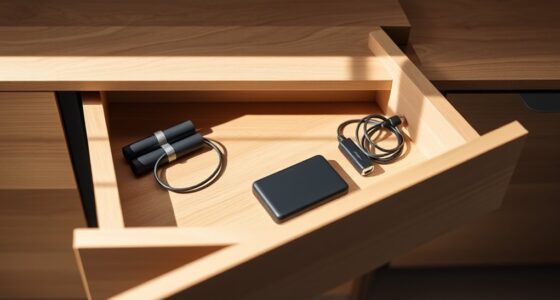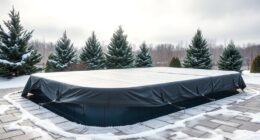To create a DIY smart diffuser for custom aromas, you can combine ultrasonic or nebulizing components with a microcontroller like Arduino or Raspberry Pi. This setup lets you control scent release, adjust intensity, and schedule diffuser operation through smartphone apps or voice commands. You can also incorporate sensors for automatic adjustments based on air quality. With modular reservoirs for easy oil swapping and safe wiring, you’ll craft a personalized, automated aroma experience that fits your style—explore further to discover how all the pieces come together.
Key Takeaways
- Utilize ultrasonic or nebulizing diffuser components for effective and customizable essential oil dispersal.
- Design modular reservoirs and automated dispensing systems for easy scent swapping and scheduling.
- Integrate microcontrollers like Arduino or Raspberry Pi for remote control, automation, and smart features.
- Ensure safety with proper insulation, food-grade oils, and aesthetically pleasing enclosures.
- DIY diffusers offer personalized scent experiences, cost savings, and the satisfaction of building tailored aromatherapy devices.

Creating your own smart diffuser is a rewarding way to customize your aromatherapy experience while saving money. When you design your own device, you gain full control over scent customization, tailoring the aroma intensity, duration, and blends to suit your mood and environment. The key to a successful DIY smart diffuser lies in understanding diffuser technology—how it disperses essential oils and integrates with smart home systems—so you can craft a device that’s both functional and personalized.
Start by selecting a suitable diffuser base. Many DIY enthusiasts repurpose small ultrasonic or nebulizing diffuser components because they’re effective at dispersing essential oils into fine mist. These devices use ultrasonic vibrations or pressurized air to break down oil molecules into tiny particles, which then diffuse into the air evenly. Incorporating diffuser technology into your project allows you to create a device that produces consistent scent output and can be controlled remotely or via automation routines.
Choose ultrasonic or nebulizing diffuser components for effective, consistent scent dispersion in your DIY smart diffuser.
Next, focus on the scent customization aspect. You’ll want a system that lets you easily add or change essential oils. Some DIY setups utilize small reservoirs with easy-access caps, so you can swap out oils without disassembling the entire device. If you’re tech-savvy, consider integrating a small pump or valve system linked to a microcontroller, enabling you to automatically dispense different oils at scheduled times. This way, you can create a dynamic aromatherapy experience that adapts to your day or mood. Additionally, by designing a modular cartridge system, you can experiment with various scent combinations, blending oils for unique aromas that reflect your personal preferences.
To make your diffuser smarter, incorporate a microcontroller like Arduino or Raspberry Pi. These boards can connect your diffuser to your Wi-Fi network, allowing remote control through an app or voice commands via smart assistants. You might add sensors to monitor room humidity or air quality, adjusting scent output accordingly. Using open-source software and DIY coding tutorials, you can program your diffuser to turn on when you arrive home, set specific scent schedules, or even cycle through different aromas throughout the day. Furthermore, understanding diffuser technology helps you troubleshoot and optimize your device for the best performance.
Finally, pay attention to safety and aesthetics. Ensure your electronic components are properly insulated, and use non-toxic, food-grade essential oils. Select a sleek enclosure that complements your home decor, making your smart diffuser not just functional but also a stylish addition to your space. By combining thoughtful design with diffuser technology, you create a customized aromatherapy device that elevates your environment, all while enjoying the satisfaction of building it yourself.
Frequently Asked Questions
Can DIY Diffusers Be Used With Essential Oils Safely?
Yes, you can use DIY diffusers with essential oils safely if you consider safety considerations and essential oil compatibility. Make sure to dilute the oils properly and avoid overloading the diffuser to prevent damage. Also, check that your diffuser materials are compatible with oils to prevent degradation. By following these guidelines, you guarantee a safe and effective aromatic experience in your home.
How Long Do Homemade Diffusers Typically Last?
Homemade diffusers typically last several weeks, but their diffuser lifespan depends on the oil evaporation rate and how often you use them. If you use a lot of oil or have a high evaporation rate, you’ll notice scent diminishes faster. To extend your diffuser’s life, refill it regularly and choose oils with slower evaporation. Keep an eye on the scent strength to know when it’s time for a refill or replacement.
Are DIY Smart Diffusers Compatible With Voice Control?
Ever wondered if your DIY smart diffuser can respond to voice commands? It’s possible if you choose components with voice command compatibility and integrate app control features. By connecting your diffuser to smart home systems like Alexa or Google Assistant, you get seamless control through voice and apps. So, yes, with the right setup, your homemade diffuser can become a voice-controlled aroma station, making home scenting smarter and more convenient.
What Safety Precautions Should I Consider When Building DIY Diffusers?
When building your DIY diffuser, prioritize electrical safety by ensuring all wiring is correct and insulated to prevent shocks or fires. Check material compatibility to avoid reactions between components and essential oils, which could cause damage or hazards. Use non-flammable materials for parts near heat sources, and work in a well-ventilated area. Always test your setup carefully before regular use, and follow safety guidelines to keep your home safe.
Can DIY Diffusers Be Integrated With Home Automation Systems?
Did you know that over 60% of smart home devices now support automation integration? You can definitely connect your DIY diffusers with home automation systems using wireless connectivity like Wi-Fi or Zigbee. This lets you control scents remotely, schedule them, or sync with lighting and music. Just make certain your diffuser has compatible wireless features, and follow safety guidelines to avoid electrical issues. It’s a smart way to personalize your space effortlessly.
Conclusion
Your DIY smart diffuser isn’t just about personalized aromas; it’s a symbol of your ability to create harmony within your space. Each scent you craft reflects your unique personality, transforming your home into a sanctuary of comfort and expression. By mastering this tech, you’re not just diffusing fragrances—you’re weaving a tapestry of memories and mood, turning everyday moments into meaningful rituals. In this way, your home becomes a fragrant mirror of your soul’s quiet, enduring beauty.









